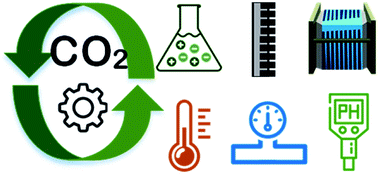Advances and challenges in electrochemical CO2 reduction processes: an engineering and design perspective looking beyond new catalyst materials
Abstract
Electrochemical CO2 reduction (CO2R) is one of several promising strategies to mitigate CO2 emissions. Electrochemical processes operate at mild conditions, can be tuned to selective products, allow modular design, and provide opportunities to integrate renewable electricity with CO2 reduction in carbon-intensive manufacturing industries such as iron and steel making. In recent years, significant advances have been achieved in the development of highly efficient and selective electrocatalysts for CO2R. However, to realize fully the potential benefits of new electrocatalysts in low cost, large scale CO2R electrolyzers requires advances in design and engineering of the CO2R process. In this review, we examine the state-of-the-art in electrochemical CO2R technologies, and highlight how the efficiency of CO2R processes can be improved through (i) electrolyzer configuration, (ii) electrode structure, (iii) electrolyte selection, (iv) pH control, and (v) the electrolyzer's operating pressure and temperature. Although a comprehensive review of catalytic materials is beyond this review's scope, we illustrate how other engineering and design decisions may also influence CO2R reaction pathways because of effects on mass transfer rates, the electrode surface chemistry, interactions with intermediate reaction species, and rates of charge transfer.

- This article is part of the themed collection: 2020 Journal of Materials Chemistry A most popular articles


 Please wait while we load your content...
Please wait while we load your content...
